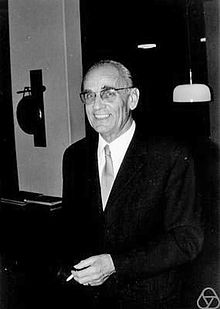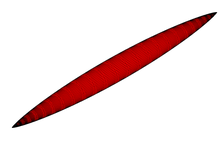Wolfgang Haack
Wolfgang Siegfried Haack | |
|---|---|
 Wolfgang Haack, around 1970 in Oberwolfach | |
| Born | 24 April 1902 |
| Died | 28 November 1994 (aged 92) |
| Citizenship | Germany |
| Education | MSc, PhD, Dr. habil. |
| Alma mater | Leibniz University Hannover, University of Jena |
| Occupation(s) | scientist, researcher, professor of mathematics and mechanics, professor of numerical mathematics |
| Known for | mechanical engineering, mathematics, aerodynamics |
Wolfgang Siegfried Haack (24 April 1902 – 28 November 1994) was a
aerodynamicist. He in 1941 and William Sears in 1947 independently discovered the Sears–Haack body.[1]
Life
Wolfgang Haack studied
TH Berlin and in 1937, he followed the call to the TH Karlsruhe. During the Second World War he worked on projectile design. Although the TH Berlin did invite him to work there in 1944, Wolfgang Haack was unable to take up the post because of the war. In 1949 he became the successor to Georg Hamel
as Professor of Mathematics and Mechanics at the TU Berlin Department of Mathematics and Mechanics. On his initiative a new Department of Computational Mathematics was founded in 1964, which he held until his retirement in 1968. In 1992 Haack was appointed as an honorary member of the Society for Applied Mathematics and Mechanics. In 1964 Haack was called to the new chair for numerical mathematics, a position he was to hold until being given emeritus status in 1968.
Applied mathematics
The interaction of Wolfgang Haack is at the interface between mathematics and mechanics. His research areas ranged from the mechanics of
dissertations
.
Haack minimum drag shapes

During
air resistance depending on caliber or diameter and length or volume and length of the profile was published in 1941 by the Lilienthal society[2]
but was kept secret during World War II.
Haack shapes or
F-16 nose appears to be a very close match to a Haack shape.[citation needed
]
Pioneer of numerical mathematics
Haack recognized early on the potential of computers for scientific and industrial research. As early as 1950 he established a working group on electronic calculating machines. He contacted
Deutsche Forschungsgemeinschaft assumed that the existing computing machines at Darmstadt, Göttingen and Munich
were sufficient for the time being. It was due to his solicitation of donations from the private industry that in 1958 the first computer at the TU Berlin was set up.
References
- ^ Palaniappan, Karthik (2004). Bodies having Minimum Pressure Drag in Supersonic Flow - Investigating Nonlinear Effects (PDF). 22nd Applied Aerodynamics Conference and Exhibit. Antony Jameson. Retrieved 2010-09-16.
- ^ "Geschoßformen kleinsten Wellenwiderstandes by W. Haack, Bericht 139 der Lilienthal-Gesellschaft (1941)" (PDF). Archived from the original (PDF) on September 27, 2007. Retrieved 2007-09-27.
- ^ Haack Minimum Drag Rifle Bullet
- ^ LM Class Bullets, very high BC bullets for windy long Ranges Archived 2008-02-19 at the Wayback Machine
